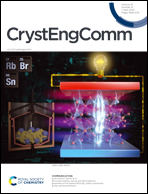On structural factors determining the nature of the fluorescent properties of OIHMs based on 8-hydroxyquinoline†
Abstract
Eighteen organic–inorganic hybrid materials (OIHMs) with d- and p-block metal halides (chlorides and bromides) and 8-hydroxyquinoline as the organic part, as well as 8-hydroxyquinoline chloride and bromide salts, have been synthesized to investigate the influence of the solid-state supramolecular structure on the emission properties. The spectroscopic properties of the obtained compounds have been analyzed experimentally and theoretically using computational chemistry methods. The analysis of multiple systems allows the formulation of general conclusions regarding the fluorescence of 8-hydroxyquinoline-based structures. In general, the emission results from processes conditioned by factors that enhance its intensity (induced by closed-shell metal cations) and those that reduce it (induced by the presence of water molecules, open-shell metal cations, and heavy element atoms, such as bromine). The significant role of π–π stacking and inter- and intramolecular hydrogen bond interactions have also been emphasized. This work provides new understanding of the relationship between supramolecular structure and emission properties in OIHMs, useful for designing new emitters for optoelectronics and sensing.



 Please wait while we load your content...
Please wait while we load your content...